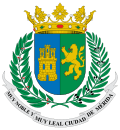Mérida, Yucatán
| Merida | ||
|---|---|---|
| City | ||
|
Collage of the city of Mérida. | ||
| ||
 Merida Location in Yucatan | ||
| Coordinates: 20°58′12″N 89°37′12″W / 20.97000°N 89.62000°WCoordinates: 20°58′12″N 89°37′12″W / 20.97000°N 89.62000°W | ||
| Country | Mexico | |
| State | Yucatan | |
| Municipality | Merida | |
| City Founded | January 6, 1542 | |
| Government | ||
| • Municipal President | Mauricio Vila Dosal ((PAN)) | |
| Elevation | 10 m (30 ft) | |
| Population (2010)[1] | ||
| • Total | 970,377 | |
| • Density | 858.41/km2 (2,223.3/sq mi) | |
| • Demonym | Meridian | |
| Time zone | CST (UTC−6) | |
| • Summer (DST) | CDT (UTC−5) | |
| ZIP code | 97000 | |
| Area code(s) | 999 | |
| Major Airport | Manuel Crescencio Rejón International Airport | |
| IATA Code | MID | |
| ICAO Code | MMMD | |
| INEGI Code | 310500001[2] | |
| Website |
merida | |
Mérida (Spanish pronunciation: [ˈmeɾiða]) is the capital and largest city of the Mexican state of Yucatán as well as the largest city of the Yucatán Peninsula. It is located in the northwest part of the state, about 35 kilometres (22 miles) from the Gulf of Mexico coast. The city is also the municipal seat of the Municipality of Mérida, which includes the city and the areas around it.
According to the 2010 census, the population of Mérida was 970,377, ranking 12th among the most populous Mexican metropolitan areas. The municipality's area is 858.41 km2 (331.43 sq mi). The metropolitan area includes the municipalities of Mérida, Umán and Kanasín and had a population of 1,035,238 in the same 2010 census. It is the largest of the four cities of the world that share the name Mérida, the other three being in Spain, Venezuela, and the Philippines.
The city, like much of the state, has heavy Mayan, Spanish, French, British, and to a lesser extent Dutch influences. Mérida has the highest percentage of indigenous persons of any large city in Mexico with approximately 60% of all inhabitants being of the Maya ethnicity.
Mérida is serviced by Manuel Crescencio Rejón International Airport (IATA airport code: MID)
History



There were three Spanish conquistadors named "Francisco de Montejo": Francisco de Montejo "el Adelantado" ("The Lieutenant", the eldest); Francisco de Montejo y León "el Mozo" ("The Boy", his son); and Francisco de Montejo "el Sobrino" ("The Nephew"). Mérida was founded in 1542 by Francisco de Montejo y León ("el Mozo") and named after the town of Mérida in Extremadura, Spain. It was built on the site of the Maya city of T'hó (/d̥ʼχøʼ/), which was also called Ichkanzihóo or Ichcaanzihó (/isʃkan'siχœ/; "City of Five Hills") in reference to its pyramids. T'ho had been a center of Mayan culture and activity for centuries: because of this, some historians consider Mérida the oldest continually-occupied city in the Americas.
Carved Maya stones from ancient T'ho were widely used to build the Spanish colonial buildings that are plentiful in downtown Mérida, and are visible, for instance, in the walls of the main cathedral. Much of Mérida's architecture from the colonial period through the 18th century and 19th century is still standing in the centro historico of the city. From colonial times through the mid-19th century, Mérida was a walled city intended to protect the Peninsular and Criollo residents from periodic revolts by the indigenous Maya. Several of the old Spanish city gates survive, but modern Mérida has expanded well beyond the old city walls.
Late in the 19th century and the early 20th Century, the area surrounding Mérida prospered from the production of henequén. For a brief period, around the turn of the 20th century, Mérida was said to house more millionaires than any other city in the world. The result of this concentration of wealth can still be seen today. Many large and elaborate homes still line the main avenue called Paseo de Montejo, though few are occupied today by individual families. Many of these homes have been restored and now serve as office buildings for banks and insurance companies. Korean immigration to Mexico began in 1905 when more than a thousand people arrived in Yucatan from the city of Incheon. These first Korean migrants settled around Merida as workers in henequen plantations.
Mérida has one of the largest centro histórico districts in the Americas (surpassed only by Mexico City and Havana, Cuba). Colonial homes line the city streets to this day, in various states of disrepair and renovation; the historical center of Mérida is currently undergoing a minor renaissance as more and more people are moving into the old buildings and reviving their former glory.
In August 1993, Pope John Paul II visited the city on his third trip to Mexico.[3] The city has been host to two bilateral United States – Mexico conferences, the first in 1999 (Bill Clinton – Ernesto Zedillo) and the second in 2007 (George W. Bush – Felipe Calderón).
In June 2007, Mérida moved its city museum to the renovated Post Office building next to the downtown market. The Museum of the City of Mérida houses important artifacts from the city's history, as well as an art gallery. Mérida hosted the VI Summit of Association of Caribbean States, in 2014.
Mérida is the cultural and financial capital of the Yucatán Peninsula, as well as the capital city of the state of Yucatán. In recent years, important science competitions and World events have been held in Mérida – FITA Archery World Cup Finals, the International Cosmic Ray Conference, a Physics Olympiad, etc.
Geography
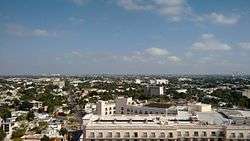
.jpg)
Mérida is located in the northwest part of the state of Yucatán, which occupies the northern portion of the Yucatán Peninsula. To the east is the state of Quintana Roo, to the west is the state of Campeche, to the north is the Gulf of Mexico, and far to the south is the state of Chiapas. The city is also located in the Chicxulub Crater. It has a very flat topography and is only 30 feet (9 m) above sea level. The land outside of Mérida is covered with smaller scrub trees and former henequen fields. Almost no surface water exists, but several cenotes (underground springs and rivers) are found across the state. Mérida has a centro histórico typical of colonial Spanish cities. The street grid is based on odd-numbered streets running east/west and even-numbered streets running north/south, with Calles 60 and 61 bounding the "Plaza Grande" in the heart of the city. The more affluent neighborhoods are located to the north and the most densely populated areas are to the south. The Centro Histórico area is becoming increasingly popular with American and other expats who are rescuing and restoring the classic colonial structures. The Los Angeles Times recently noted this surge of interest in rescuing Mérida's historic downtown.[4]
Climate
Merida features a tropical wet and dry climate (Köppen: Aw).[5] The city lies in the trade wind belt close to the Tropic of Cancer, with the prevailing wind from the east. Mérida's climate is hot and its humidity is moderate to high, depending on the time of year. The average annual high temperature is 33 °C (91 °F), ranging from 28 °C (82 °F) in January to 36 °C (97 °F) in May, but temperatures often rise above 38 °C (100 °F) in the afternoon in this time. Low temperatures range between 18 °C (64 °F) in January to 23 °C (73 °F) in May and June. It is most often a few degrees hotter in Mérida than in coastal areas due to its inland location and low elevation. The rainy season runs from June through October, associated with the Mexican monsoon which draws warm, moist air landward. Easterly waves and tropical storms also affect the area during this season.
| Climate data for Mérida (1951–2010) | |||||||||||||
|---|---|---|---|---|---|---|---|---|---|---|---|---|---|
| Month | Jan | Feb | Mar | Apr | May | Jun | Jul | Aug | Sep | Oct | Nov | Dec | Year |
| Record high °C (°F) | 39.5 (103.1) |
39.5 (103.1) |
42.0 (107.6) |
43.0 (109.4) |
43.0 (109.4) |
41.5 (106.7) |
40.0 (104) |
43.0 (109.4) |
40.0 (104) |
39.0 (102.2) |
39.0 (102.2) |
39.5 (103.1) |
43.0 (109.4) |
| Average high °C (°F) | 30.8 (87.4) |
31.5 (88.7) |
34.0 (93.2) |
35.6 (96.1) |
36.3 (97.3) |
35.3 (95.5) |
35.0 (95) |
34.9 (94.8) |
34.2 (93.6) |
32.7 (90.9) |
31.5 (88.7) |
30.6 (87.1) |
33.5 (92.3) |
| Daily mean °C (°F) | 24.0 (75.2) |
24.4 (75.9) |
26.3 (79.3) |
27.9 (82.2) |
29.0 (84.2) |
28.5 (83.3) |
28.2 (82.8) |
28.1 (82.6) |
27.9 (82.2) |
26.8 (80.2) |
25.4 (77.7) |
24.0 (75.2) |
26.7 (80.1) |
| Average low °C (°F) | 17.2 (63) |
17.3 (63.1) |
18.6 (65.5) |
20.2 (68.4) |
21.7 (71.1) |
21.6 (70.9) |
21.4 (70.5) |
21.3 (70.3) |
21.6 (70.9) |
20.8 (69.4) |
19.3 (66.7) |
17.5 (63.5) |
19.9 (67.8) |
| Record low °C (°F) | 9.2 (48.6) |
9.5 (49.1) |
9.0 (48.2) |
10.0 (50) |
10.0 (50) |
10.0 (50) |
10.0 (50) |
10.0 (50) |
10.0 (50) |
10.0 (50) |
10.0 (50) |
7.0 (44.6) |
7.0 (44.6) |
| Average rainfall mm (inches) | 38.4 (1.512) |
32.2 (1.268) |
22.5 (0.886) |
24.4 (0.961) |
69.4 (2.732) |
138.3 (5.445) |
158.7 (6.248) |
140.7 (5.539) |
183.1 (7.209) |
127.9 (5.035) |
56.2 (2.213) |
45.1 (1.776) |
1,036.9 (40.823) |
| Average rainy days (≥ 0.1 mm) | 4.2 | 3.3 | 2.3 | 1.9 | 4.6 | 10.8 | 13.4 | 12.8 | 13.9 | 9.7 | 5.4 | 4.3 | 86.6 |
| Average relative humidity (%) | 70 | 68 | 63 | 64 | 63 | 71 | 72 | 73 | 76 | 75 | 75 | 73 | 70 |
| Mean monthly sunshine hours | 208.6 | 205.9 | 241.8 | 254.1 | 273.2 | 231.0 | 246.1 | 247.9 | 208.5 | 218.5 | 212.4 | 201.8 | 2,749.8 |
| Source #1: Servicio Meteorologico Nacional (humidity 1981–2000)[6][7] | |||||||||||||
| Source #2: NOAA (sun 1961–1990)[8] | |||||||||||||
Culture
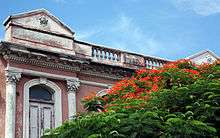
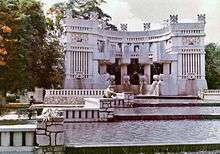
Mérida has been nicknamed "The White City" (La Ciudad Blanca"), though the exact origin of this moniker is not clear. Some explanations include the common color of its old buildings painted and decorated with "cal" (though anyone visiting modern Mérida can see that buildings are not all white nowadays) or the fact that the residents keep the city particularly clean. Mérida was named after the Spanish town of the same name, originally (in Latin) Augústa Emérita (see Mérida, Spain). Mérida served as the American Capital of Culture in the year 2000.
As the state and regional capital, Mérida is a cultural center, featuring multiple museums, art galleries, restaurants, movie theatres, and shops. Mérida retains an abundance of beautiful colonial buildings and is a vibrant cultural center with music and dancing playing an important part in day-to-day life. At the same time it is a modern city boasting a comprehensive range of shopping malls, auto dealerships, top quality hotels, restaurants, and leisure facilities. The famous avenue, Paseo de Montejo, is lined with original sculpture. Each year, the MACAY Museum in Mérida mounts a new sculpture installation, featuring works from Mexico and one other chosen country. Each exhibit remains for ten months of the year. In 2007, sculptures on Paseo de Montejo featured works by artists from Mexico and Japan.

Mérida and the state of Yucatán have traditionally been isolated from the rest of the country by geography, creating a unique culture. The conquistadors found the Mayan culture to be incredibly resilient, and their attempts to eradicate Mayan tradition, religion, and culture had only moderate success. The surviving remnants of the Mayan culture can be seen every day, in speech, dress, and in both written and oral histories. It is especially apparent in holidays like Hanal Pixan, a Mayan/Catholic Day of the Dead celebration. It falls on November 1 and 2 (one day for adults, and one for children) and is commemorated by elaborate altars dedicated to dead relatives. It is a compromise between the two religions with crucifixes mingled with skull decorations and food sacrifices/offerings. Múkbil pollo (pronounced/'mykβil pʰoʎoˀ/) is the Mayan tamal pie offered to the dead on All Saints' Day, traditionally accompanied by a cup of hot chocolate. Many Yucatecans enjoy eating this on and around the Day of the Dead. And, while complicated to make, they can be purchased and even shipped via air. (Muk-bil literally means "to put in the ground" or to cook in a pib, an underground oven).
For English speakers or would-be speakers, Mérida has the Mérida English Library,[9] a lending library with an extensive collection of English books, videos, tapes, and children's books. The library is also the site for expatriate meetings, children's storytelling hours, and other cultural events.
Mérida is also home to the Yucatan symphony orchestra, which plays regular seasons at the Jose Peon Contreras Theatre on Calle 60 and features classical music, jazz, and opera.[10]
Food
Yucatecan food is its own unique style and is very different from what most people consider "Mexican" food. It includes influences from the local Mayan culture, as well as Caribbean, Mexican, European and Middle Eastern cultures.

There are many regional dishes. Some of them are:
- Poc Chuc, a Mayan/Yucateco version of boiled/grilled pork.
- Salbutes and Panuchos. Salbutes are soft, cooked tortillas with lettuce, tomato, turkey and avocado on top. Panuchos feature fried tortillas filled with black beans, and topped with turkey or chicken, lettuce, avocado and pickled onions. Habanero chiles accompany most dishes, either in solid or purée form, along with fresh limes and corn tortillas.
- Queso Relleno is a "gourmet" dish featuring ground pork inside of a carved edam cheese ball served with tomato sauce
- Pavo en Relleno Negro (also known locally as Chilmole) is turkey meat stew cooked with a black paste made from roasted chiles, a local version of the mole de guajalote found throughout Mexico. The meat soaked in the black soup is also served in tacos, sandwiches and even in panuchos or salbutes.
- Sopa de Lima is a lime soup with a chicken broth base often accompanied by shredded chicken or turkey and crispy tortilla.
- Papadzules. Egg "tacos" bathed with Pumpkin Seed sauce and tomatoes.
- Cochinita pibil is a marinated pork dish and by far the most renowned from the Yucatecan food.
- Bul keken, (Mayan for "beans and pork") is a traditional black bean and pork soup. The soup is served in the home on Mondays in most Yucatán towns. The soup is usually served with chopped onions, radishes, chilies, and tortillas. This dish is also commonly referred to as frijol con puerco.
- Brazo de reina, (Spanish for "The Queen's Arm") is a traditional tamal dish. A long, flat tamal is topped with ground pumpkin seeds and rolled up like a roll cake. The long roll is then cut into slices. The slices are topped with a tomato sauce and a pumpkin seed garnish.
Achiote a popular spice in the area. It is derived from the hard annatto seed found in the region. The whole seed is ground together with other spices and formed into a reddish seasoning paste, called recado rojo. The other ingredients in the paste include cinnamon, allspice berries, cloves, Mexican oregano, cumin seed, sea salt, mild black peppercorns, apple cider vinegar, and garlic.
Hot sauce in Mérida is usually made from the indigenous chiles in the area which include: Chile Xcatik, Chile Seco de Yucatán, and Chile Habanero.
Language and accent
The Spanish spoken in the Yucatán is readily identifiable as different, even to non-native ears. It is heavily influenced by the Yucatec Maya language, which is spoken by a third of the population of the State of Yucatán. The Mayan language is melodic, filled with plosive consontants (p', k', and t') and "sh" sounds (represented by the letter "x" in the Mayan language).
Being enclosed by the Caribbean Sea and the Gulf of Mexico, and with poor land communication with the rest of Mexico, Yucatecan Spanish has also preserved many words that are no longer used in many other Spanish speaking areas of the world. However, with the improvement in transportation and especially with the overwhelming presence of radio, internet, and TV, their isolation has eroded, and many elements of the culture and language of the rest of Mexico are now slowly but consistently permeating the culture.
Apart from the Mayan language, which is still the mother-tongue of many Yucatecans, students now choose to learn a foreign language like English, which is taught in most schools.
Transportation
Bus
City Service is mostly provided by 4 local transportation companies: Unión de Camioneros de Yucatán (UCY), Alianza de Camioneros de Yucatán (ACY), Rápidos de Mérida, and Minis 2000. Bus Transportation is at the same level or better than that of bigger cities like Guadalajara or Mexico City. Climate Controlled buses and Micro-Bus (smaller in size) are not uncommon.
The Main Bus Terminal (CAME) offers 1st Class (ADO) and luxury services (ADO PLATINO, ADO GL) to most southern Mexico cities outside Yucatán with a fleet consisting of Mercedez Benz and Volvo buses. Shorter intrastate routes are serviced by many smaller terminals around the city, mainly in downtown.
Taxis
Several groups and unions offer Taxi transportation: Frente Único de los Trabajadores del Volante (FUTV) (white taxis), Unión de Taxistas Independientes (UTI), and Radiotaxímetros de Yucatán, among others. Some of them offer metered service, but most work based on a flat rate depending on destination. Competition has made it of more common use than it was years ago.
Taxis can be either found at one of many predefined places around the city (Taxi de Sitio), waved off along the way or called in by Radio.
Unlike the sophisticated RF counterparts in the US, a Civil Band radio is used and is equally effective. Usually a taxi will respond and arrive within 5 minutes.
Another type of Taxi service is called "Colectivo". Colectivo taxis work like small buses on a predefined route and for a small fare. Usually accommodating 8 to 10 people.
Air
Mérida is serviced by Manuel Crescencio Rejón International Airport with daily non-stop services to major cities in Mexico (D.F, Monterrey, Villahermosa, Cancún, Guadalajara, Tuxtla Gutierrez, Toluca) and international (Miami, Houston, La Havana) and usually receiving charter flight services to and from Europe and Canada. Also there is a good amount of freight and cargo planes moving in and out. As of 2006 more than a million passengers were using this airport every year, (1.3 in 2007) and it is under ASUR administration.
Train
There is no passenger train service to the city yet (which is generally the case for Mexican cities), although freight trains do serve the area.
Roads
Main roads in and out of Mérida:
- Mérida-Progreso (Federal 261), 33 kilometres (21 miles) long with 8 lanes. It joins the city with Yucatán's biggest port city, Progreso.
- Mérida-Umán-Campeche (Federal 180), connects with the city of San Francisco de Campeche.
- Mérida-Kantunil-Cancún (Federal 180), 4 lane road that becomes a Toll road at kantunil. It joins Mérida with Chichén Itzá, Valladolid and ultimately Cancún.
- Mérida-Tizimín (Federal 176) connects Mérida with Tizimín (2nd. largest city in Yucatán).
- Mérida-Teabo-Peto known as Mundo Maya Road Carretera del Mundo Maya, its utilized in both "convent route" Ruta de los Conventos, and linking the ancient maya city of Mayapán and Chetumal, state capitol of Quintana Roo
Health

Mérida has many regional hospitals and medical centers. All of them offer full services for the city and in case of the Regional Hospitals for the whole Yucatán peninsula and neighboring states.
The city has one of the most prestigious medical faculties in Mexico (UADY). Proximity to American cities like Houston allow local Doctors to crosstrain and practice in both countries making Mérida one of the best cities in Mexico in terms of health services availability.
Hospitals:
- Public:
- Hospital Regional del ISSSTE.
- Hospital Ignacio García Téllez Mexican Social Security Institute (IMSS).
- Hospital Benito Juárez IMSS.
- Hospital Agustin O'Horán.
- Hospital Regional de Alta Especialidad.
- Private:
- Clínica de Mérida
- Star Médica
- Centro Médico de las Américas. (CMA)
- Centro de Especialidades Médicas
- Hospital Santelena.
- Centro Médico Pensiones (CMP)
Education
In 2000 the Mérida municipality had 244 preschool institutions, 395 elementary, 136 Jr. high school (2 years middle school, 1 high), 97 High Schools and 16 Universities/Higher Education schools. Merida has consistently held the status of having the best performing public schools in Mexico since 1996.
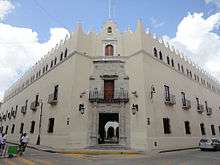
There are several state institutions offering higher education:
- Universidad Autónoma de Yucatán (UADY)
- Universidad Tecnológica Metropolitana (UTM)
- Instituto Tecnológico de Mérida (ITM)
- Escuela Superior de Artes de Yucatán (ESAY)
- Universidad Pedagógica Nacional
- Escuela Normal Superior de Yucatán (ENSY)
- Universidad Nacional Autónoma de México (UNAM)
Among several private institutions:
- Institute of Modern Spanish (IMS)
- Centro de Estudios Superiores CTM (CESCTM)
- Colegio de Negocios Internacionales (CNI)
- Universidad Anáhuac Mayab
- Universidad Marista
- Centro de Estudios Universitarios del Mayab (CEUM)
- Universidad Modelo
- Universidad Interamericana para el Desarrollo (UNID)
- Centro Educativo Latino (CEL)
- Universidad Interamericana del Norte
- Centro Universitario Interamericano(Inter)
- Universidad Mesoamericana de San Agustin (UMSA)
- Centro de Estudios de las Américas, A.C. (CELA)
- Universidad del Valle de Mexico (UVM)
- Instituto de Ciencias Sociales de Merida (ICSMAC)
- Universidad Popular Autónoma de Puebla, Plantel Mérida (UPAEP Mérida)
Mérida has several national research centers. Among them
- Centro de Investigacíón Científica de Yucatán (CICY)
- Centro de Investigaciones Regionales Dr. Hideyo Noguchi, dependent from the UADY, conducts biological and biomedical research.
- Centro INAH Yucatán, dedicated to anthropological, archaeological and historic research.
- Centro de Investigación y de Estudios Avanzados CINVESTAV/IPN
Politics
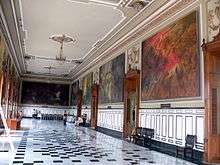
Mérida is the Yucatán state capital. State government officials reside here and it's also the base for the Mérida Municipality. "El Ayuntamiento" is constituted by an elected major, assembly representatives and síndicos. . The current mayor is Mauricio Villa Dosal, from the PAN and he took office on July 1, 2015. State Governor is Mr. Rolando Zapata Bello (PRI) appointed July 2, 2012.
Consulates
Current consular representations in Mérida are:
- Consulate of Austria
- Consulate of Belize
- Consulate of Cuba
- Consulate of Finland
- Consulate of France
- Consulate of Germany
- Consulate of Greece
- Consulate of Honduras
- Consulate of Lebanon
- Consulate of Luxembourg
- Consulate of the Netherlands
- Consulate of South Korea
- Consulate of Spain
- Consulate of the United States
Main sights
Historic sites


- Monumento à la Patria (1956)
- Palacio de Gobierno (1892)
- Catedral de San Ildefonso (1598), first in the continental Americas.
- Barrio y Capilla de Santa Lucía (1575)
- Barrio y Templo Parroquial del antiguo pueblo de Itzimná
- Barrio y Templo Parroquial de San Cristóbal (1796)
- Barrio y Templo Parroquial de San Sebastián (1706)
- Barrio y Templo Parroquial de Santa Ana (1733)
- Barrio y Templo Parroquial de Santa Lucía (1575)
- Barrio y Templo Parroquial de Santiago (1637)
- Capilla de Nuestra Señora de la Candelaria (1706)
- Capilla y parque de San Juan Bautista (1552)
- Casa de Montejo (1549)
- Antiguo convento de Nuestra Señora de la Consolación (Nuns)(1596)
- Iglesia del Jesús o de la Tercera Orden (Third Order) (1618)
- Templo de San Juan de Dios (1562)
Cultural centers
- Centro Cultural Andrés Quintana Roo, in Santa Ana, with galeries and artistic events.
- Centro Cultural Olimpo. Next to the Municipal Palace in the Plaza Grande.
- Casa de la Cultura del Mayab, the Casa de Artesanías (house of handcrafts) resides there. It's in downtown Mérida.
- Centro Estatal de Bellas Artes (CEBA). Across the El Centenario, offers classes and education in painting, music, theater, ballet, jazz, folclore, spanish dance, among others.
- Centro Cultural del Niño Yucateco (CECUNY) in Mejorada, in a 16th-century building, with classes and workshops specifically designed for kids.
- Centro Cultural Dante a private center within one of the major bookstores in Mérida (Librería Dante).
Museums

- Gran Museo del Mundo Maya, Yucatán's Mayan Museum, offers a view of Yucatán's history and identity.
- Museo de Antropología e Historia "Palacio Cantón", Yucatán's history and archaeology Museum.
- Museo de Arte Contemporáneo Ateneo de Yucatán (MACAY), in the heart of the city right next to the Cathedral. Permanent and rotating pictorial expositions.
- Museo de la Canción Yucateca Asociación Civil in Mejorada, honors the trova yucateca authors, Ricardo Palmerín, Guty Cárdenas, Juan Acereto, Pastor Cervera y Luis Espinosa Alcalá.
- Museo de la Ciudad de Mérida, in the old Correos (post office) building since 2007 offers information about the city from the prehispanic times' Tho' or Ichcaanzihó to current days.
- Museo de Historia Natural, natural history museum.
- Museo de Arte Popular, popular art museum, offers a view of popular artistry and handcrafts among ethnic Mexican groups and cultures.
- Museo Conmemorativo de la Inmigración Coreana a Yucatán.
Major theaters with regular shows
- Teatro José Peón Contreras
- Teatro Daniel Ayala Pérez
- Teatro Mérida (Now Teatro Armando Manzanero)
- Teatro Colón
- Teatro Universitario Felipe Carrillo Puerto
- Teatro Héctor Herrera
Sports
Several facilities can be found where to practice sports:
- Estadio Salvador Alvarado in the north
- Unidad Deportiva Kukulcán (with the major Soccer Stadium Carlos Iturralde, Kukulcan BaseBall Park and Polifórum Zamná multipurpose arena)
- Complejo deportivo La Inalambrica, in the west ( with archery facilities that held a world series championship )
- Unidad deportiva Benito Juarez Garcia, in the northeast.
- Gimnasio Polifuncional, where professional basketball team Mayas de Yucatán plays for the Liga Nacional de Baloncesto Profesional de México (LNBP) representing Yucatán.
| Team | Sport | League | Stadium |
|---|---|---|---|
| Leones de Yucatán | Baseball | Liga Mexicana de Beisbol | Parque Kukulkán |
| F.C. Itzaes | Football (Soccer) | Segunda División de México | Estadio Carlos Iturralde |
| Mérida F.C. | Football (Soccer) | Liga de Ascenso de México | Estadio Carlos Iturralde |
| Mayas de Yucatán | Basketball | Liga Nacional de Baloncesto Profesional | Gimnasio Polifuncional |
International relations
Twin towns – sister cities

Mérida, Yucatán is twinned with 12 cities:[11]
 Erie, United States (1973)
Erie, United States (1973) New Orleans, United States (June 9, 1990)
New Orleans, United States (June 9, 1990) Panama City, United States (November 13, 2003)
Panama City, United States (November 13, 2003) Glendora, United States (1973)
Glendora, United States (1973) Sarasota, United States (2010)
Sarasota, United States (2010) Mérida, Spain (October 12, 1990)
Mérida, Spain (October 12, 1990) Incheon, South Korea (October 15, 2007)
Incheon, South Korea (October 15, 2007) Texcoco, Mexico (May 22, 2001)
Texcoco, Mexico (May 22, 2001) Camagüey, Cuba (February 6, 2000)
Camagüey, Cuba (February 6, 2000) Mérida, Venezuela (October 12, 1990)
Mérida, Venezuela (October 12, 1990) Chiquinquirá, Colombia (March 26, 1999)
Chiquinquirá, Colombia (March 26, 1999) Pereira, Colombia (April 17, 2000)
Pereira, Colombia (April 17, 2000) Monterrey, Mexico (2014)[12]
Monterrey, Mexico (2014)[12]
References
- ↑ Instituto Nacional de Estadística y Geografía (2005). "Principales resultados por localidad (ITER)".
- ↑ INEGI. "Archivo Histórico de Localidades. Mérida" (in Spanish). Retrieved August 18, 2010.
- ↑ Fodor's 2001 Cancún, Cozumel, Yucatán Peninsula p.167. Fodor's, 2000
- ↑ Dickerson, Marla (October 21, 2007). "Paradise for home remodelers – Los Angeles Times". Latimes.com. Retrieved 2009-05-05.
- ↑ Peel, M. C. and Finlayson, B. L. and McMahon, T. A. (2007). "Updated world map of the Köppen–Geiger climate classification" (PDF). Hydrol. Earth Syst. Sci. 11: 1633–1644. doi:10.5194/hess-11-1633-2007. ISSN 1027-5606.
- ↑ "Estado de Yucatán-Estacion: Merida Centro". Normales Climatologicas 1951–2010 (in Spanish). Servicio Meteorologico Nacional. Retrieved April 25, 2015.
- ↑ "NORMALES CLIMATOLÓGICAS 1981–2000" (PDF) (in Spanish). Servicio Meteorológico Nacional. Retrieved April 25, 2015.
- ↑ "Merida Climate Normals 1961–1990". National Oceanic and Atmospheric Administration. Retrieved April 25, 2015.
- ↑ "Merida English Library". Merida English Library. Retrieved 2009-05-05.
- ↑ "The Yucatan Symphony Orchestra". Osy.org.mx. Retrieved 2013-03-12.
- ↑ City Hall of Mérida, Yucatán, México. Dirección de Cultura. Sister Cities department.
- ↑ http://yucatan.com.mx/mexico/politica-mexico/merida-y-monterrey-fortalecen-lazos-sociales-y-economicos
- Murphy, Kate. "Mérida: Finding a Home (Cheerios Included) in Mexico". The New York Times. March 12, 2006.
- Link to tables of population data from Census of 2005 INEGI: Instituto Nacional de Estadística, Geografía e Informática
- Yucatán Enciclopedia de los Municipios de México
External links
| Wikimedia Commons has media related to Mérida, Yucatán. |
| Wikivoyage has a travel guide for Mérida (Mexico). |
| |||||||||||||||||||||||||||||||||||||||||||||||||||||||
| ||||||
|

